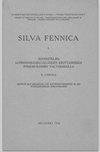Influence of mechanical site preparation on regeneration success of planted conifers in clearcuts in Fennoscandia – a review
IF 1.7
3区 农林科学
Q2 FORESTRY
引用次数: 34
Abstract
In the Nordic countries Finland. Norway and Sweden, the most common regeneration method is planting after clearcutting and, often, mechanical site preparation (MSP). The main focus of this study is to review quantitative effects that have been reported for the five main MSP methods in terms of survival and growth of manually planted coniferous seedlings of Norway spruce (Picea abies (L.) Karst.), Scots pine (Pinus sylvestris L.) and lodgepole pine (Pinus contorta var. latifolia Engelm.) in clearcuts in these three countries. Meta analyses are used to compare the effects of MSP methods to control areas where there was no MSP and identify any relationships with temperature sum and number of years after planting. In addition, the area of disturbed soil surface and the emergence of naturally regenerated seedlings are evaluated. The MSP methods considered are patch scarification, disc trenching, mounding, soil inversion and ploughing. Studies performed at sites with predominately mineral soils (with an organic topsoil no thicker than 0.30 m), in boreal, nemo-boreal and nemoral vegetation zones in the three Fenno-Scandinavian countries are included in the review. Data from 26 experimental and five survey studies in total were compiled and evaluated. The results show that survival rates of planted conifers at sites where seedlings are not strongly affected by pine weevil (Hylobius abietis L.) are generally 80-90% after MSP, and 15-20 percent units higher than after planting in non-prepared sites. The experimental data indicated that soil inversion and potentially ploughing (few studies) give marginally greater rates than the other methods in this respect. The effects of MSP on survival seem to be independent of the temperature sum. Below 800 degree days, however, the reported survival rates are more variable. MSP generally results in trees 10-25% taller 10-15 years after planting compared to no MSP. The strength of the growth effect appears to be inversely related to the temperature sum. The compiled data may assist in the design, evaluation and comparison of possible regeneration chains, i.e. analyses of the efficiency and cost-effectiveness of multiple combinations of reforestation measures.机械整地对芬诺斯坎迪亚林下人工针叶树更新成功的影响
在北欧国家芬兰。在挪威和瑞典,最常见的再生方法是在砍伐后种植,通常是机械整地(MSP)。本研究的主要重点是回顾已报道的五种主要MSP方法在人工种植挪威云杉(Picea abies (L.))针叶幼苗存活和生长方面的定量效应。喀斯特松(Pinus sylvestris L.)和黑松(Pinus contorta var. latifolia Engelm.)在这三个国家的空旷地带。Meta分析用于比较MSP方法在控制没有MSP的地区的效果,并确定与温度总和和种植后年数的任何关系。此外,还评估了扰动土壤表面面积和自然再生苗的出苗率。所考虑的MSP方法是斑块划痕,圆盘沟,堆筑,土壤翻转和翻耕。在三个芬诺-斯堪的纳维亚国家的北方、近北方和近北方植被带的主要矿质土壤(有机表土厚度不超过0.30米)地点进行的研究包括在审查中。汇编和评估了总共26项实验研究和5项调查研究的数据。结果表明,在松象鼻虫(Hylobius abietis L.)对幼苗影响不强的地点,灌浆后针叶树的成活率一般为80 ~ 90%,比未灌浆的地点高出15 ~ 20%。试验数据表明,土壤翻转和潜在耕作(很少有研究)在这方面的比率略高于其他方法。MSP对存活的影响似乎与温度和无关。然而,在800华氏度以下,报告的存活率变化更大。与没有MSP相比,MSP通常会在种植10-15年后使树木高10-25%。生长效应的强度似乎与温度和成反比。汇编的数据可有助于设计、评价和比较可能的再生链,即分析多种重新造林措施组合的效率和成本效益。
本文章由计算机程序翻译,如有差异,请以英文原文为准。
求助全文
约1分钟内获得全文
求助全文
来源期刊

Silva Fennica
农林科学-林学
CiteScore
3.50
自引率
11.10%
发文量
21
审稿时长
3 months
期刊介绍:
Silva Fennica publishes significant new knowledge on forest sciences. The scope covers research on forestry and forest ecosystems. Silva Fennica aims to increase understanding on forest ecosystems, and sustainable use and conservation of forest resources. Use of forest resources includes all aspects of forestry containing biomass-based and non-timber products, economic and social factors etc.
 求助内容:
求助内容: 应助结果提醒方式:
应助结果提醒方式:


